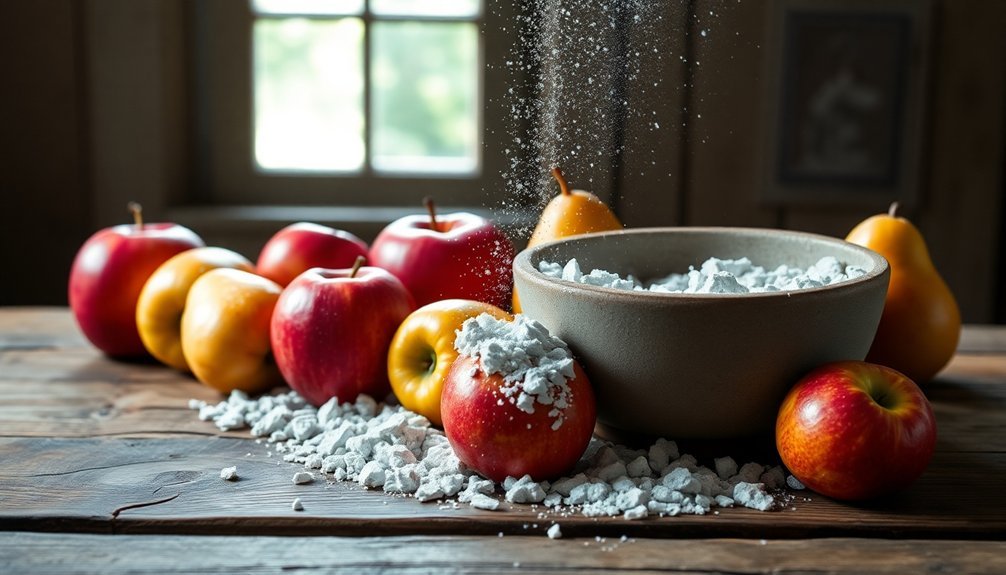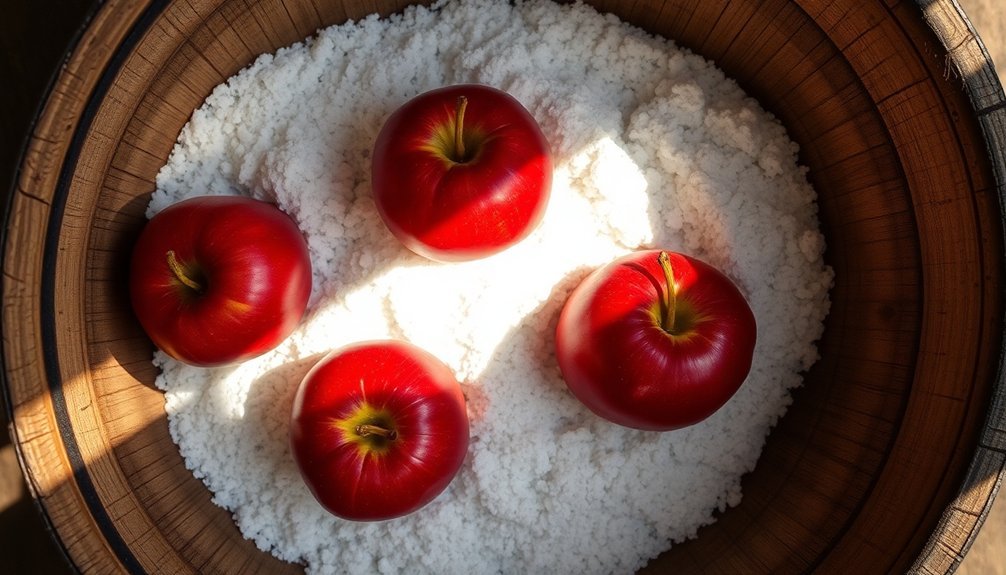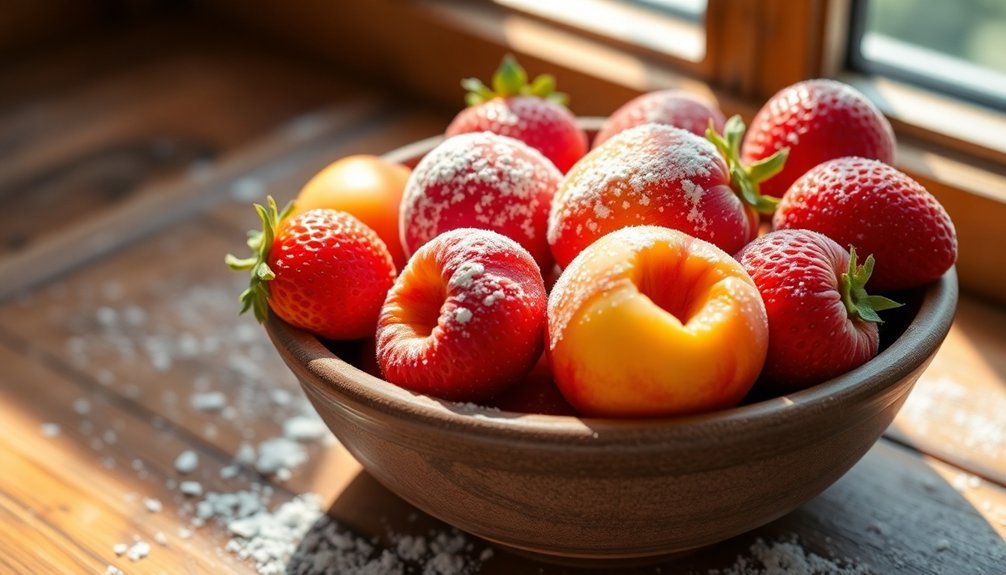You'll find three proven wood ash preservation methods to keep your fresh fruits, especially tomatoes, lasting for months. The traditional layering technique uses 1.5 inches of fine wood ash between layers of fruit, placed stem-end down. The ash box storage system requires a structured approach with a specific ratio of 1.5 kg ash per 1 kg of fruit in a lined container. For smaller quantities, try single fruit ash preservation, where you individually wrap fruits in ash. Each method can extend storage life up to six months, and there's much more to discover about these time-tested preservation techniques.
Traditional Layering Technique

Wood ash preservation, a time-tested method passed down through generations, offers an effective way to store fresh tomatoes for extended periods.
You'll need to start by selecting firm, ripe tomatoes that are free from blemishes and bruises, ensuring they're clean and suitable for long-term storage.
To prepare your ash, sift it multiple times to remove debris and sharp particles. You'll want fine, dry ash from a cooking fire or chimney. The ash's high alkaline properties help prevent bacterial growth and extend preservation time.
Once you've gathered your materials, line a wooden, cardboard, or woven basket with paper and spread a 1.5-inch layer of ash at the bottom.
Place your tomatoes stem-end down in a single layer, making sure they don't touch each other. Cover them completely with a thin layer of ash, then add another layer of tomatoes.
Continue this process until you've filled your container. You'll need to seal it properly to keep the ash undisturbed.
Store your container in a cool, dry place and check it periodically. While the tomatoes' skin may wrinkle over time, the pulp will stay juicy.
When done correctly, this preservation method can keep your tomatoes fresh for up to six months.
Ash Box Storage System
Building on the traditional layering approach, the ash box storage system offers a more structured method for preserving your fresh tomatoes.
You'll need to start with properly prepared wood ash that's cool, finely sifted, and free from debris. Using hardware cloth or mesh, verify your ash is refined to a consistent texture without any sharp particles or contaminants.
Select a wooden box, cardboard container, or woven basket as your storage vessel. You'll want to line it with paper before adding your first ash layer. Start by spreading about 1.5 inches of ash on the bottom, then place your tomatoes stem-side down in a single layer.
Continue alternating between ash and tomatoes until you've filled the container, maintaining the ratio of 1.5 kg of ash per 1 kg of tomatoes.
Place your ash box in a cool, dark basement or similar environment where temperature and humidity remain stable. Based on recent experiments, however, you may notice a strong musty odor when rinsing the fruit after storage. When done correctly, this storage system can preserve your tomatoes for up to 5-6 months.
While you may notice some changes in firmness over time, the inner flesh should stay juicy, and you'll find that your tomatoes maintain higher sugar content with minimal rotting compared to untreated ones.
Single Fruit Ash Preservation

When preserving individual tomatoes, the single fruit ash method offers a more flexible approach than bulk storage systems. You'll need to start by selecting tomatoes that are ripe but still firm, ensuring they're free from any bruises or blemishes. Choose varieties that are specifically bred for long-keeping traits to maximize your preservation success. Post-harvest losses can significantly impact small-scale farmers who need storage solutions.
Your wood ash preparation is essential for this method. You'll want to sift the cooled ash multiple times to remove any sharp particles or debris that could damage the fruit. The ash should be completely dry and sourced from various tree species for best results.
Don't mix it with other materials, as this could compromise its effectiveness.
To preserve each tomato, create a 1.5-inch base layer of ash in your container. Place the tomatoes stem-end down and cover them with a thin layer of ash. Continue this layering process until you've filled your container.
Store it in a cool, dry location away from direct sunlight and air circulation. When done correctly, you can expect your tomatoes to stay preserved for up to 5-6 months, though results may vary based on initial fruit quality and storage conditions.
Frequently Asked Questions
Can Wood Ash From Burned Pine Needles Be Used for Fruit Preservation?
You can use pine needle ash for fruit preservation, but it's untested and may differ from traditional wood ash. You'll need to verify its pH levels and guarantee it's properly cooled and sifted first.
How Does Wood Ash Preservation Affect the Nutritional Value of Fruits?
You won't notice significant changes in your fruits' nutritional value when using wood ash preservation. Research shows it doesn't impact sugar content, pH levels, or overall nutrient profiles in any meaningful way.
Is It Safe to Preserve Citrus Fruits Using Wood Ash?
No, you shouldn't preserve citrus fruits with wood ash. It's not safe because the ash's alkaline nature can harm the fruit's quality and potentially introduce toxins. Stick to freezing, refrigeration, or traditional preservation methods.
What Happens if the Stored Fruits Freeze During Winter Storage?
If your fruits freeze, you'll notice they become mushy when thawed due to ruptured cell walls. You'll also face reduced quality, texture changes, and potential microbial growth once they thaw out.
Can Wood Ash Preservation Work With Fruits Harvested During Rainy Weather?
You shouldn't preserve fruits harvested in rainy weather, as they'll be too wet and prone to mold. Wait for dry weather to harvest, and make sure your fruits are completely dry before using wood ash.
In Summary
You've now learned three effective ways to preserve fresh fruits using wood ash. Whether you're layering fruits in traditional ash beds, creating a dedicated ash box storage system, or preserving individual pieces, these time-tested methods will help extend your harvest's shelf life. Remember to use only hardwood ash and check your preserved fruits regularly. With these techniques, you'll enjoy fresh fruit long after the growing season ends.





Leave a Reply